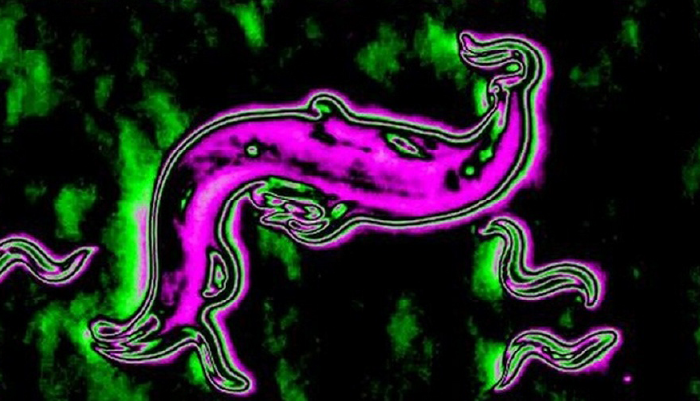
Pristionchus pacificus precision predation. Adult P. pacificus wildtype predating on C. elegans wildtype larvae that are composed of unique surface chemistry as identified using 3D-OrbiSIMS
Credit: University of Nottingham - Veered Chauhan
New research has provided the most detailed molecular profile yet of nematode surface chemistry, revealing how lipid compositions change with development and influence predator-prey interactions.
Using high-resolution 3D-OrbiSIMS mass spectrometry, scientists at the University of Nottingham and the Max Planck Institute for Neurobiology of Behavior characterized the outermost 50 nanometers of two nematode species – Caenorhabditis elegans and Pristionchus pacificus. The research demonstrates that over 80 percent of the nematode surface chemistry consists of lipids, with species-specific differences likely shaped by evolutionary adaptation.
“Discovering that these worms have predominantly oily, or lipid-based, surfaces is a significant step in understanding their biology,” stated lead author Veeren Chauhan in a recent press release. “These lipid surfaces help maintain hydration and provide a barrier against bacteria, which are essential for their survival.”
The team used 3D-OrbiSIMS to achieve sub-micron spatial resolution imaging of the nematode cuticle, which allowed them to track molecular changes throughout development. They found that C. elegans adults had longer-chain fatty acids and triglycerides compared with larvae, whereas P. pacificus displayed a distinct chemical profile dominated by ceramides and phospholipids. These variations in lipid composition are likely to play a role in species-specific adaptations, including predator-prey interactions.
Demonstrating this functional role, the researchers found that predation by P. pacificus on C. elegans was mediated by surface lipids. When the metabolic pathway governing lipid composition was disrupted in C. elegans mutants lacking the peroxisomal fatty acid β-oxidation enzyme DAF-22, their susceptibility to predation increased. “The predatory behavior of P. pacificus is guided by physical contact with the surface lipids of its prey, and alterations in these lipids can increase the susceptibility of the prey to predation,” explained Chauhan.
